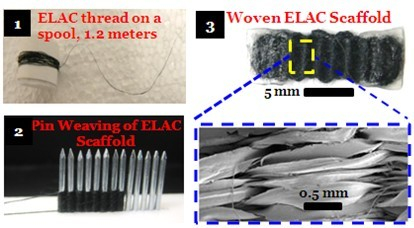-
Electrochemically Aligned Collagen (ELAC) for Tendon Tissue Engineering Applications
The research group led by Dr. Akkus invented the ELAC technology. Using support from NIH (R21), NSF and Alfred Mann Foundation, we developed a novel biofabrication method to process monomeric collagen solutions by applying electric current to generate electrochemically aligned collagen (ELAC) threads, whose fabric orientation and packing density match those of the native tendon (Fig. 1). The degree of alignment of ELAC when examined by polarized microscopy is comparable with the native tendon (Fig. 2). The genipin crosslinking conditions of ELAC threads have been improved to obtain threads which match the failure strength (110 MPa) and modulus (0.9 GPa) of tendon. ELAC threads promote adhesion and proliferation of human mesenchymal stem cells (Fig. 3). Furthermore, we have demonstrated that human mesenchymal stem cells seeded on ELAC undergo tenogenic differentiation in the absence of bioinductive factors. Implantation of braided ELAC threads within rabbit patellar tendon demonstrated that ELAC degrades and resolves into a tendon-like tissue gradually in a time frame of months without eliciting a significant immune or inflammatory response. The mechanical robustness enables weaving of ELAC threads as porous bulk scaffolds that can be populated by cells in vitro and in vivo. We can synthesize ELAC threads in sufficient lengths that can be collected on spools and used to fabricate porous scaffolds by using the pin-weaving method (Fig. 4). These porous scaffolds can be integrated to the repair site by sutures to facilitate tendon regeneration. Therefore, ELAC carries a significant potential for repair of critical sized tendon defects.
A. Schematic of basic electro-chemical cell layout for collagen alignment; B. Polarized image confirming the alignment of ELAC; C. Human mesenchymal stem cells on ELAC threads at day 1 and day 14. Cell form a confluent layer on day 14. Scale bar: 0.5 mm.
Fabrication of a porous ELAC scaffold using pin-weaving method for the repair of critical sized tendon defects.


